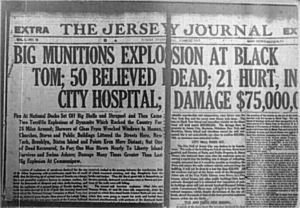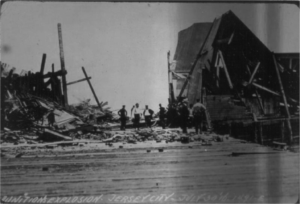….In 1916
Following the blog posts about Tunney and Eagan, a number of correspondents have asked for more detail about the German saboteur campaign in the US of the period. I’ve recently undertaken an analysis of this campaign (and one other from history) to compare current C-IED “Attack the Network” strategies with previous C-IED Attack the Network efforts. The German saboteur campaign is fascinating not only for the parallels with modern terrorism and the lessons learned and since forgotten, but some very interesting operational aspects from both the enemy and friendly forces.
This campaign by German saboteurs saw a number of cells operating in the New York and New Jersey areas attack 47 factories, 43 ships and a number of docks and railway facilities over about a 2 year period from 1915- 1917. They used both explosive IEDs and incendiaries. Many German ships were being blockaded in US ports by the British and the sailors provided ample human resources for the German authorities efforts to prevent the industrial might of the US from providing munitions for the French, British and Russians fighting Imperial Germany, before the US entered the war in 1917.
There were many interesting attacks which I will blog in the future. The biggest was an arson attack on the Black Tom munition loading facility on the New Jersey shoreline, right opposite The Statue of Liberty. Incendiaries were set by German agents and there is strong evidence to suggest that some local watchman were paid to turn a blind eye, at the very least. Some time later the fire took hold and caused a detonation of 1000 tons of explosives. The Statue of Liberty was damaged, windows were broken across Manhattan and the explosion heard as far away as Philadelphia and Maryland. According to one source it was measured at 5.5 on the Richter scale. Remarkably few people were killed however.


After the war a reparations committee sat for many years and argued whether the Black Tom explosion was sabotage or not. Eventually in 1939 the German government agreed to pay reparations – but WW2 intervened and a $50 million reparation was finally paid in 1979.
A memorial stone at the scene, within sight of lower Manhattan records the incident calling it “One of the worst acts of terrorism in American history”.
After the war the response to the German Saboteur threat was assessed in retrospect (leading eventually to the formation of the FBI under Hoover), and I rather like this quote from the former New York Police Commissioner, Tunney’s former boss:
“The lessons to America are clear as day. We must not again be caught napping with no adequate national intelligence organization. The several Federal bureaus should be welded together into one, and that one should be eternally and comprehensively vigilant.”
Arthur Woods, former Police Commissioner NYPD 1919

Good stuff Roger, as usual. It's particularly interesting that growing up in the US I never heard about the actual sabotage events that occurred in this era. Looks like there is gold to be mined there.
TomB